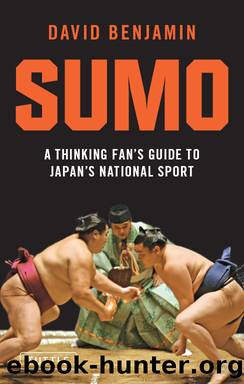Sumo: A Thinking Fan's Guide to Japan's National Sport by David Benjamin

Author:David Benjamin [Benjamin, David]
Language: eng
Format: epub
Tags: Sports & Recreation, Martial Arts, General, Wrestling, history, Asia, Japan
ISBN: 9784805310878
Google: YJ-dQAAACAAJ
Publisher: Tuttle Publishing
Published: 2010-03-10T23:16:00.620953+00:00
Chiyonofujiâs Ghosts
But Chiyonofuji lost again, on Day 8, to Kotonishiki, and stirred familiar concerns among both his friends and rivals. More than six months before, the only American sumo coach, Jesse Kuhaulua (who has three other names, by the way⦠rikishi name: Takamiyama; oyakata name: Azumazeki; Japanese name: Daigoro Watanabe) had bluntly said that Chiyonofuji was over the hill and he would hang up his codpiece in 1990. Chiyo quickly shut Jesse up by winning the 1990 New Year Basho in January. But the Wolf missed the title in March with a 10-5 record and lost again in May at 13-2. When Kotonishiki overpowered Chiyo on Day 8 in Nagoya, even Chiyoâs coach, Kokonoe, began to worry. Kokonoe was pessimistic before Chiyonofujiâs Day 10 test against Akinoshima â a stubborn little defensive specialist everybody hated to wrestle. Akinoshima had actually spent one whole day as the un-beaten basho leader â before a resounding loss to Asahifuji. Regardless of his basho record, Akinoshima was always at his best against the best and he represented â with the possible exception of Konishiki â Chiyoâs most fearsome opponent.
Against Chiyonofuji in Nagoya, however, Akinoshima (talented but dumb) was out of his league. Chiyo came into the match with a plan and creamed the kid without breaking a sweat. âHe rose like a phoenix,â said Kokonoe. âI stopped worrying.â
But Junko and I were still worrying. And so, I suspect, was the Sumo Association. Chiyonofuji was sumoâs official cover boy â on most editions of the official sumo program. When Japan Airlines produced a TV commercial featuring the 1990 Sumo Tour to Brazil, the guy the producers would put out front was a foregone conclusion. The Wolf. Everybody else in the commercial â including Futagoyama, head of the Sumo Association â brought up the rear.
Although itâs easy to forget, Chiyonofuji had not always enjoyed such favor from the Establishment. When he decided to take some of his physical training outside the sacred dungeon of the sumobeya, to a fitness center where he lifted weights and sculpted his rippling mass of upper-body muscle, he violated a sumo taboo. Only when he became an idol of millions, the handsomest sumo star of the 20th Century, and the winningest rikishi of the â80s, did the Sumo Association declare no-hard-feelings and embrace Chiyonofuji as the symbol of all that is good and pure in the sport.
Chiyo was, indeed, a hard guy to hate. He was good-looking, with a (relatively) small tummy, and that face â smooth, rugged, and kissable enough for one of those âTake it all offâ Noxzema shaving commercials. His physique was, by any athletic standard, impressive. Naked, he could be mistaken for an NFL linebacker, a heavyweight contender, or a large economy-size Cosmo centerfold. His athleticism would have made him a star in a dozen other sports, and his charm resulted in thoughtful, modest, humorous interviews. He was everybodyâs favorite son.
Of course, this means that, coming into the final match in Nagoya, he was under terrific pressure.
Download
This site does not store any files on its server. We only index and link to content provided by other sites. Please contact the content providers to delete copyright contents if any and email us, we'll remove relevant links or contents immediately.
Spare by Prince Harry The Duke of Sussex(5077)
Machine Learning at Scale with H2O by Gregory Keys | David Whiting(4194)
Fairy Tale by Stephen King(3222)
Will by Will Smith(2795)
Hooked: A Dark, Contemporary Romance (Never After Series) by Emily McIntire(2502)
The Bullet Journal Method by Ryder Carroll(2487)
Rationality by Steven Pinker(2291)
Can't Hurt Me: Master Your Mind and Defy the Odds - Clean Edition by David Goggins(2230)
It Starts With Us (It Ends with Us #2) by Colleen Hoover(2203)
Friends, Lovers, and the Big Terrible Thing by Matthew Perry(2126)
The Becoming by Nora Roberts(2091)
Love on the Brain by Ali Hazelwood(1965)
HBR's 10 Must Reads 2022 by Harvard Business Review(1779)
The Strength In Our Scars by Bianca Sparacino(1778)
A Short History of War by Jeremy Black(1764)
Leviathan Falls (The Expanse Book 9) by James S. A. Corey(1651)
515945210 by Unknown(1602)
A Game of Thrones (The Illustrated Edition) by George R. R. Martin(1594)
Bewilderment by Richard Powers(1541)
